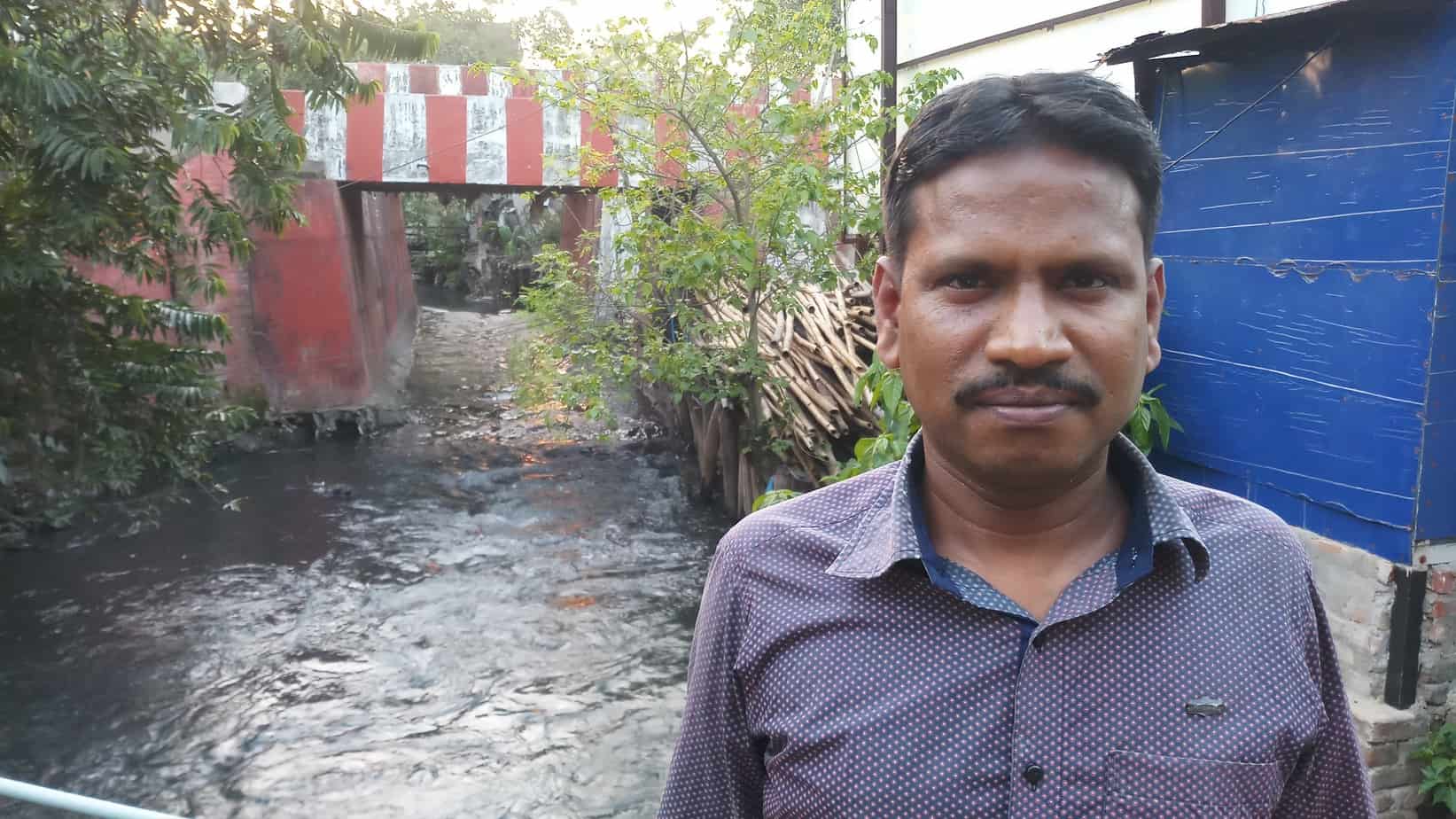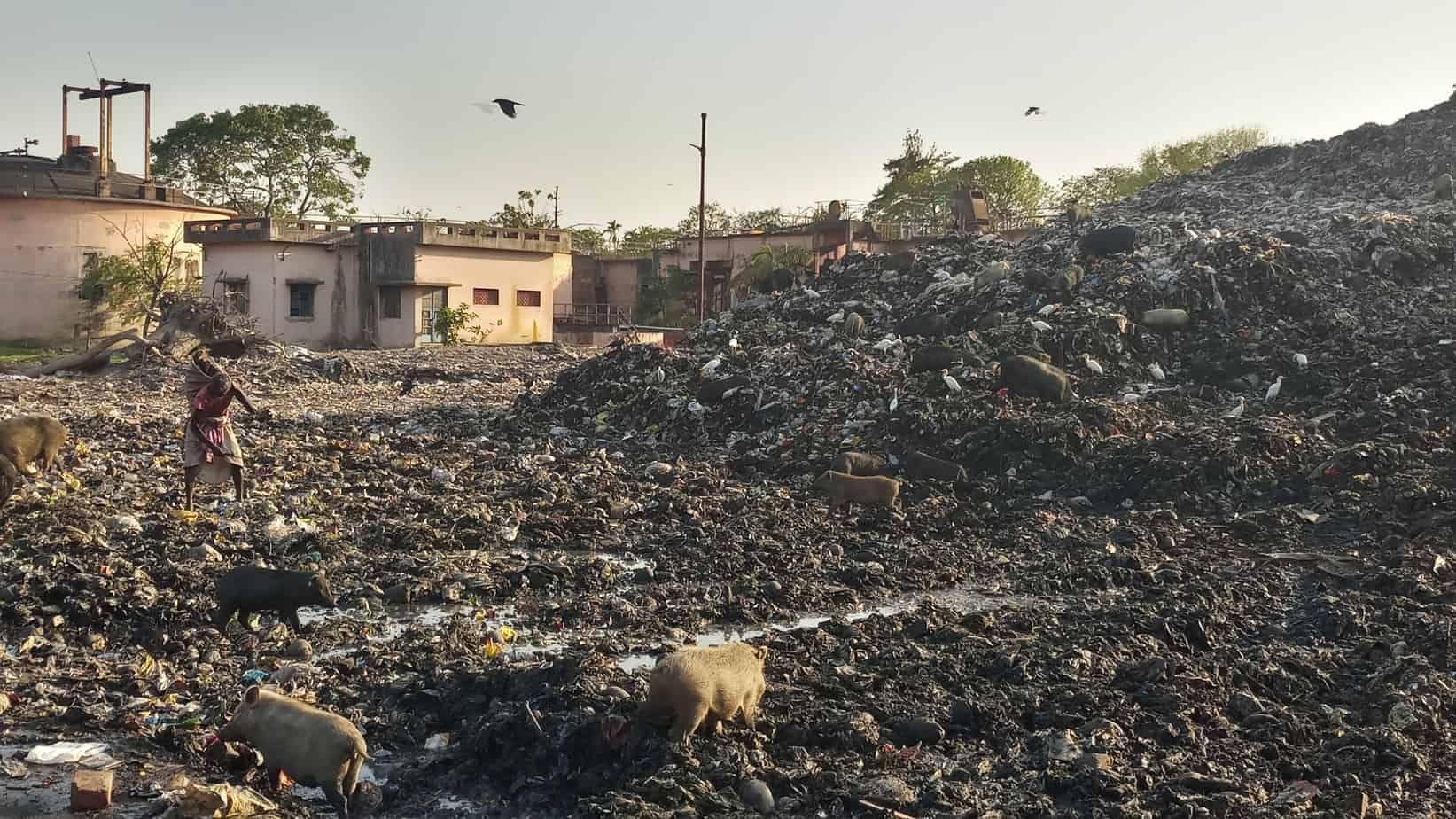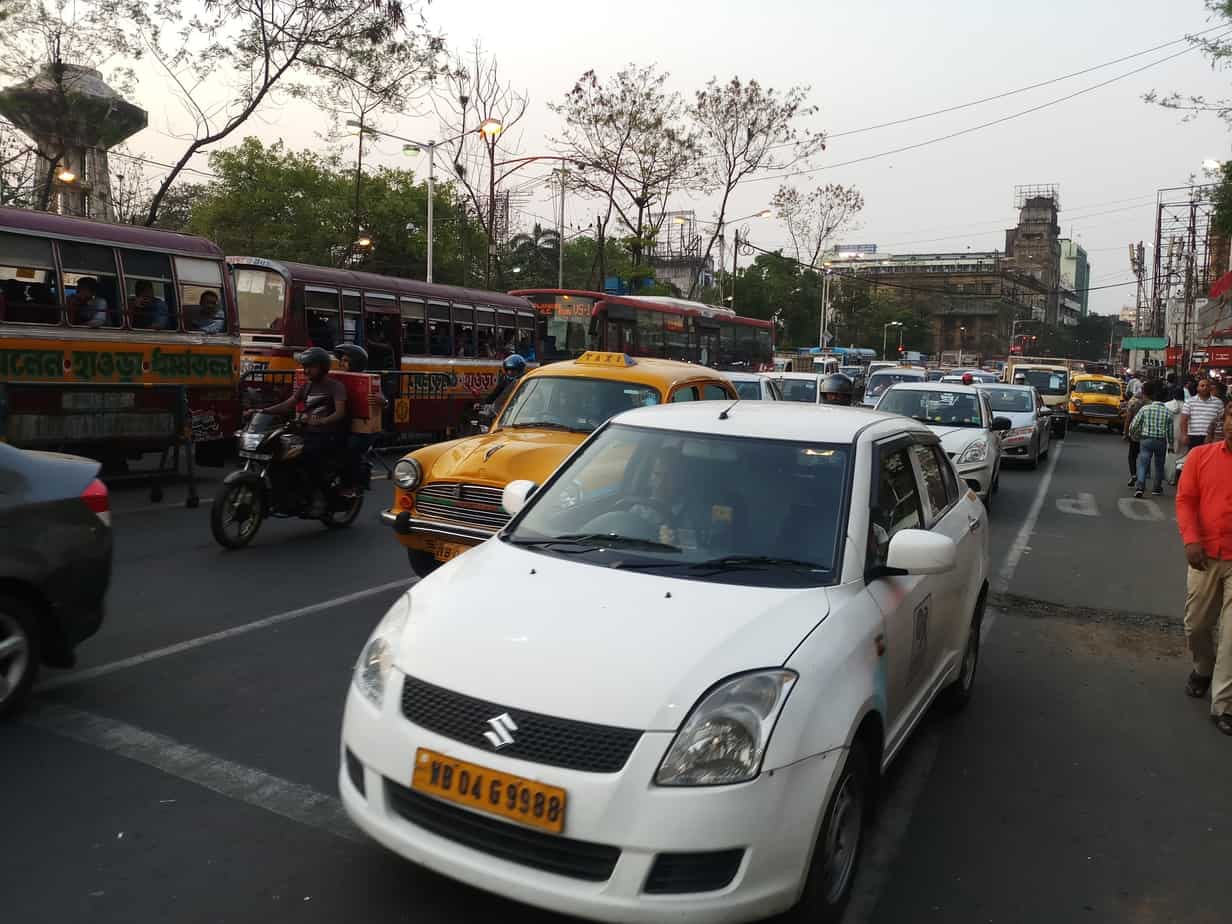Raj Kumar Jena resides in a slum close to Noapara metro station at Baranagar in Kolkata. Standing on the narrow viaduct below the station he watches several trains chugging into the last station of metro connectivity in the northern fringes of the city. Under the cemented viaduct, flows the Bagjola drainage canal carrying blackish water full of household waste and emitting a putrid smell.
Jena however does not look to be as hit by the smell as you would expect him to be. Perhaps, because he lives with it. More than the polluted canal, he says, the unbearable stench from the nearby garbage disposal ground has made life hell for him and hundreds of other residents in the area. Situated at a distance of one-kilometre from the metro station, the Baranagar dumping ground receives almost 500 tonnes of solid waste every day from the four municipalities of Dum Dum, North and South Dum Dum and Baranagar.
“Sometimes, it becomes difficult to roam in the locality without covering our noses with handkerchiefs because of the stench that seems to be everywhere. Even the clothes that we wear smell foul at times. We often face breathlessness, but are slowly become habituated to it,” he says with a resigned smile.

Raj Kumar Jena. PIc: Gurvinder Singh
Animesh Banerjee (name changed on request), 38, a government school teacher who resides in Pramod Nagar, near the dumping ground claims that cancer has been rapidly spreading in the locality and three people have already succumbed in the past one year. “We have been noticing that cancer is spreading fast in the area and some deaths have already been noted.”
While there have been no definitive scientific studies to link this to the quality of air in this area or the city in general, several assessments in the past have pointed to the alarming exposure to harmful multipollutants and the impact on health. In 2016, the New Delhi-based research and advocacy agency Centre for Science and Environment (CSE) released the findings of an assessment, stating that the air in Kolkata has high levels of toxins that are cancer-causing. These toxins are dangerous even in very small doses, the report mentioned.
At a recent news meet in the city, a leading radiation oncologist from the Narayana Super Speciality Hospital also said that breathing Kolkata air was almost akin to smoking cigarettes. Doctors at the meet identified air pollution as a key factor behind lung impairment, cancer and high mortality rates even among non-smoker and teetotaller patients.**
Rising air pollution levels in the city
It is no secret that Kolkata has been in the grip of severe air pollution contributing to the deteriorating health of residents in the city and its outskirts. Studies conducted both by government and private organisations have found that harmful pollutants in the air have been wreaking havoc on air parameters of the city.
Latest data by West Bengal Pollution Control Board (WBPCB) shows that Air Quality Index (AQI) level has been worsening in the city and PM 2.5 and PM 10 constitute a big chunk of harmful pollutants in the air. PM 2.5 is particularly dangerous as the smaller particles penetrate into the lungs and cause cardiovascular disease leading to heart attacks, asthma and bronchitis and can even impair brain development in children. PM 10 typically causes nasal and upper respiratory tract health problems.
Incidentally, the WBPCB has only two ambient air quality monitoring stations in the city — one installed at Victoria Memorial and the other inside the complex of Rabindra Bharati University (RBU) and sustained readings show the acute exposure of citizens to hazardous air quality.
| Date | Location | Reading | Category |
| 02 January | Rabindra Bharati University(RBU) | 362 | Very poor |
| 02 January | Victoria Memorial | 329 | Very poor |
| 26 January | RBU | 330 | Very poor |
| 26 January | Victoria memorial | 246 | Poor |
| 26 March | RBU | 271 | Poor |
| 26-27 March | RBU | 284 | Poor |
| 26 March | Victoria Memorial | 155 | moderate |
| 26-27 March | Victoria Memorial | 166 | moderate |
Many causes of pollution
Flawed waste management is a huge contributing factor behind the abysmal quality of air. The Waste Management Rules 2016 divide waste in six categories and lay down clear and stringent rules for the disposal of each, but these are hardly followed in the city. Tonnes of waste without any segregation continue to be dumped in landfills such as the one mentioned above. These dumps catch fire continually and billowing smoke from the same injects the already polluted air with more toxic contaminants.

Dumping ground at Noapara. Pic: Gurvinder Singh
Ironically, despite the evident threat to environment and human health in the vicinity of such dumping grounds, the Kolkata Municipal Corporation (KMC) is in search of fresh grounds now that the Dhapa ground — one of the oldest sites that has been accepting the city’s mixed waste since the 1980s — has been filled beyond capacity. Efforts towards reduction and segregation at source are minimal.
The KMC has started distributing coloured bins in eight wards for segregation of waste in a pilot project but in the absence of awareness among people and lack of substantial and sustained efforts to generate such awareness, such sporadic attempts are reduced to photo ops and create little impact on the overall waste scenario in the landfills.
Exhaust emissions from vehicles operating on fossil fuels, burning of solid waste in garbage dumping sites, indiscriminate construction and discharge of toxic waste from industrial units have been largely blamed for the steadily deteriorating air in the city.
Vehicular emissions contribute to nearly 60 percent of air pollution in mega cities, said Somendra Mohan Ghosh, an auto emissions consultant in the city, adding that around 99 percent of commercial vehicles in the city are diesel driven. In 1999, Ghosh had filed a PIL in the green bench of Calcutta High Court about the rising air pollution in the city. Taking note of the plea, the bench had constituted a ten member committee included cops, staff of pollution control board, environment department and others. In 2000, the committee submitted its report to the court conceding the increase of pollution levels in the city.
The vehicle population in South Kolkata is 6 lakh, 13.7 lakh in Central Kolkata and 7 lakh in north Kolkata. On July 18, 2008, the Calcutta High Court had banned the entry of commercial vehicles older than 15 years in Kolkata Metropolitan Area (KMA) but activists allege that the ban is being regularly flouted due to the laxity of the administration in most of the suburban areas in KMA.

Vehicular emissions are a key source of air pollution in Kolkata. Pic: Gurvinder Singh
“The BS IV standards were made mandatory in Kolkata but it is violated under actual driving conditions because of the frequent change of gear, clutch and breaks in slow speed. It leads to a 20 percent increase in pollution level. Checking is lax as the motor vehicles department lacks the required infrastructure for monitoring vehicles,” said Ghosh.
“Even Kolkata airport is not pollution free. Vehicles carrying cargo are run on diesel and petrol rather than on electric as mandated by the central government. Many junk vehicles engaged in the airport operating with diesel and petrol engines should be checked for clean transport management,” he added.
Little scrutiny by Environment Authority
Apart from landfill and vehicular emissions, many believe that the construction boom particularly over the past one decade has also been contributing to air pollution in the city.
A study done by Legal Initiative For Forest and Environment (LIFE), a Delhi-based non-profit working on environment has claimed that the State Level Environment Impact Assessment Authority (SEIAA) had approved all the projects in building and construction sector in 2017. The non-profit noted that 21 meetings were conducted by the SEIAA in 2017, in which 97 different projects in West Bengal came up for either scoping or appraisal. The authority granted Environmental Clearances to 40 projects out of which building and construction sector was the highest with 15 approvals, followed by mining of minor minerals.
“We found that projects were rarely scrutinised on environmental grounds, especially with regard to air pollution. Even where the question of environment arose, project proponents were directed to submit additional information and projects got deferred, but not rejected. Traffic snarls and road density factors were not kept in mind while clearing these projects,” pointed out Kankana Das, analyst at LIFE.
The Environment Authority, however, rebutted the allegations by LIFE, “After receiving the Project proposal, a detailed Project Appraisal is made by the State Expert Appraisal Committee (SEAC) in each case, with inputs from the subject matter specialists. A detailed list of stipulated conditions is prepared by the SEAC, which is then sent to SEIAA. It is only after receiving the sanctioned plans, along with compliance or commitment to comply with the stipulated conditions during operation of the project, that the Environmental Clearance is issued,” said Ujjwal Bhattacharya, Chairman of SEIAA, West Bengal. He also said that traffic and other issues are duly considered before giving Environmental Clearances.
Given the construction boom, it is also pertinent to note that The Construction and Demolition Waste Management Rules, 2016 framed by the environment ministry at the Centre, provides comprehensive guidelines on segregation, storage, collection, reuse, recycling, transportation and disposal of construction and demolition waste generated, but the rules are rarely observed in the city, as the following images testify.
Health impacts of Air Pollution
Evidently, the most telling impact of this pollution has been on the health of citizens. Doctors at the National Allergy Asthma Bronchitis Institute (NAABI) have found in their ongoing research that incidence of obstructive airway diseases and Chronic Obstructive Pulmonary Disease (COPD) has doubled to 40 percent from 20 percent in the past five years. Doctors claim that 4 out of every 10 persons in the city are suffering from obstructive airways diseases.
“The bronchoscopy test shows that airway passages of patients are highly congested and full of mucopurulent secretions. We can now confirm that air pollution has been directly leading to increases in mortality. The situation is worse in the congested areas of Kolkata,” claimed Dr A G Ghoshal, Medical Director at NAABI.
A comparison of age-adjusted incidence rates of lung cancer from the first 10 cancer registries of main cities in India also shows Kolkata at the top. The CSE report referred to above also drew upon a study carried out by researchers of University of Kolkata in 2013. This report stated that diesel cars constituted 65 per cent of new car sales in Kolkata. “About 99 per cent of commercial vehicles in Kolkata are diesel driven. This is a very serious concern as the WHO has classified diesel emissions as class 1 carcinogen for its strong link with lung cancer – putting it in the same class as tobacco smoking,” says the CSE analysis.
In fact, apart from assessing only specific pollutants for cancer potency, the International Agency for Research on Cancer (IARC), a World Health Organisation agency, has classified outdoor air pollution as a whole as a group 1 carcinogen, which is “carcinogenic to humans.”**
Does anyone care?
The awareness campaigns run by environmentalists in the city seem to have struck a chord with ordinary citizens who are definitely more aware of the pollution menace in the city than they were a few years back.
“We are constantly trying to make people aware that air pollution has an insidious and disastrous effect on our health and quality of life,” said Ajay Mittal, founder of Kolkata Clean Air, a community led initiative that seeks to make Kolkata one of the most liveable and climate friendly cities in the world.
Many citizens now think of raising this critical issue with their prospective candidates before casting the vote for them.“The politicians seek our votes by making lofty promises but they do nothing. The government has been taking no concrete action in checking emissions from the vehicles. We would definitely raise the issue when the candidate of our area comes seeking votes,” said Sujay Verma, a hardware engineer who lives at Girish Park area in north Kolkata.
None of the parties, though, seem to be taking this seriously enough and the ruling Trinamool makes no mention of tackling pollution as an issue, even in its manifesto. In Pramod Nagar, near the Baranagar dumping ground, Animesh Banerjee says none of the candidates who visited the area during campaigns made any notable mention of this very critical issue affecting people in the constituency.
There is one independent candidate, however, who seems to have based his campaign predominantly on pollution. Niraj Agarwal, a cyber expert is contesting from South Kolkata on issues like increasing pollution, education and preventive health care which almost sounds strange, given the high decibel and intensely political battle in the state.
“The level of pollution is on rise in the city and it is high time when people should step forward and take action for its control. I realized that contesting polls could be the best way to raise awareness on these issues, as control in pollution levels will obviously bring down the expenditure on health care as well. I am conducting door to door campaigns and trying to explain the ill-effects of pollution to the people,” says the 37-year-old who claims to be receiving support even from his opponents on these issues.
Meanwhile, officials at the primary state agency responsible for controlling and mitigation air issues, the West Bengal Pollution Control Board (WBPCB), are reticent, citing cases filed by noted city-based environmentalist Subhas Dutta. Dutta has filed several cases at the National Green Tribunal over air pollution caused by road repair, fires in the Dhapa Dumping ground, plying of old vehicles, burning of solid waste and other related issues.
“The matter is already sub judice and I cannot say anything,” said Dr Kalyan Rudra, the chairman of the WBPCB, referring to the NGT proceedings. Activists, however, dismissed his statement as a strategic ploy to evade questions on the government’s failure to curb rising levels of air pollution in Kolkata.
Looking to the future
Civil activists trying to create awareness on air pollution emphasize creation of alternative modes of transport as a solution. “The time has come when people should start using alternative systems of transport like trams, electrical buses and e-rickshaws. The frequency of trams should also be increased and commuters should opt for metro trains to reduce their dependency on private vehicles and public transport emitting toxic gases,” said Ajay Mittal of Kolkata Clean Air.
It is true that some beginnings have been made. Around 20 electric buses introduced in February 2019 now run on three routes namely Airport-Joka, Shyambazar-Nabanna and Tollygunge-Bidhannagar. The 20 buses are part of the state government plan’s to start 80 electric buses in 10 routes in a phased manner. But till the combination of factors behind the toxic air in the city are addressed in a planned, coordinated and urgent manner, this may just turn out to be a case of too little, too late.
** The article has been expanded with some additional points since it was first published.
| This article is part of a series produced under the Citizen Matters – Sustainable Cities Reporting Fellowship , supported by Climate Trends. |